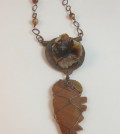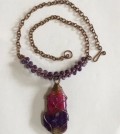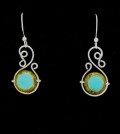- NEW DVD Series – Stone Setting with Bezels
- Tube Set Charm by Kim St. Jean
- Prong Basket Pendant by Kim St. Jean
- NEW DVD Series – Stone Setting with Cold Connections
- New DVD Series – Stone Setting with Wire
- NEW DVD Series: Introduction to Stone Setting by Kim St. Jean
- Featured Tool: Bracelet Bending Plier
- NEW Dvd by Eva Sherman
- Fun, Fast Fold Forming DVD Series
- Double Band Ear Cuff from Alex Simkin
Wire Jewelry Resource Sept 12: Introduction to Chain
by Rose Marion, Wire-Sculpture.com
Wire Jewelry Idea for
September 12, 2012
We take it for granted and buy it, or we make it ourselves; we buy by the foot, or with clasps already attached; we hang jewelry on it, or cut it up into links and make tasseled earrings from it. It’s jewelry chain, and rather than take it for granted, let’s discover what makes up chain, and how it’s come to us from our ancestors through history!
What is Chain?
Chain, by definition, is a series of usually metal links or rings, connected to or fitted into one another, and used for various purposes (Merriam-Webster). That about sums it up: on a large scale, chain has been used to sink ships (in the Revolutionary War, gigantic, hundred-pound chain links were sunk in rivers to “fence” out British ships), and on a fine scale, chain has adorned our ears, necks, and wrists for over 6,000 years. Keep reading to find where chain started, ideas how to use it, and see chain being made!
History of Chain
Chains date at least back to 2500 BC, and we can give credit to the Ancient Egyptians for threading links of gold and silver together – much like we thank them for hammering out sheets of gold and rolling it into early wire. Gold was plentiful in Classical Greece, and the Greeks created 3-dimensional pendants to wear on the chains. Around the 8th century BC, “strap chain” was developed, which is strands of chain that are connected to lie side-by-side, creating a fabric-like flexible band.
By 300 BC, the elite upper-class was wearing chains that contained gemstones in the links. Leonardo da Vinci improved on chain design during the Renaissance, a period when personal ornamentation was starting to become a must. In medieval times, the brooch was the most common piece of jewelry; in the Renaissance, this shifted to a pendant worn on a long gold chain.
For the upper classes, these lavish pendants often illustrated Biblical scenes, or emblems representing the names of saints or loved ones. More functional pendants have been found, as well, such as pendants containing toothpicks!
Fast-forward to the 18th century, and chain’s use has remained much the same, with an added task: the muff, a lady’s roll of fur to place her hands in to keep them toasty, often had a chain that went around the lady’s neck. Called a muff chain, this is also seen in children’s mittens!
As time passed, technology progressed to automate and standardize the making of chain, making steps like soldering the links (which often caused the entire link to become fused and unmovable) predictable and quick. There’s a video at the bottom of this post showing just that!
Types of Modern Chain
There are countless styles of jewelry chain, but we will be exploring some of the most famous and well-known types in the coming weeks, such as rolo, omega, snake, curb, ladder, and more. (Yes – if you have a good, close-up picture of a chain you love, send it to tips@wire-sculpture.com and you could be featured!)
When buying bulk chain, a typical label is either “soldered” or “unsoldered” chain. This means that the individual links that make up the chain are either soldered together, or have simply been pressed back together. Most base metal chain for jewelry-making is unsoldered, because it is a higher time and labor cost, but the chain still stays together well. Soldered chain can still be found, especially in the precious metals and larger-link chain.
If you see chain that says “finished” or “unfinished,” that typically means that the chain has a clasp attached (finished) or not (unfinished).
Uses for Chain
Chain has been used to make sleek necklaces, anklets, and bracelets, which may have pendants or beads on them. Large-link chain has been used to make charm bracelets, and is currently becoming popular to use extremely large links of chain (1″ and larger) to make statement necklaces.
As a wire artist, because of your skills making simple loops and wrapped loops, you can do nearly anything you like with a piece of chain! Here are some ideas to get you started:
Chain has also been used through history to make pocket-watches retrievable (called a vest chain, it has a toggle at the end so as to not fall through the buttonhole of a vest), to attach to reading glasses; and to make connected jewelry such as a nose-ring connected to an earring, or a ring connected to a bracelet (this is also called a slave bracelet). Some women today also wear fine belts made out of chain, over clothing or as part of a beach ensemble!
Besides fashionable use, chains are also used for religious purposes still today. The Catholic Rosary is traditionally made using chain links, and follows a set formula of groups of beads. This is a meaningful project that even a beginning wire jewelry artist could accomplish and practice techniques on. Metal charms such as miraculous medals (featuring Mary) and other saints’ medals are often given to children to be worn on chains: the St. Christopher medal, patron of travelers, is one of the most popular medals. A simple cross on a chain is a special gift for many Christian children, and wearing a Star of David, Hamsa (open hand), or Celtic knot charm is an important religious symbol for others.
Materials Used to make Modern Chain
Gold chain is typically made with brass (for easier manufacturing and strength) and copper (for color), resulting in a 14kt or similar alloy. While gold and silver are beautiful, not everyone can afford spools of gold chain to make beautiful jewelry from – so we turn to materials such as silver-plated chain, copper chain, and more. Even copper chain is often plated, with a harder, more cost-effective metal underneath, such as steel. If the chain is magnetic, it is most likely plated. While this is not a bad thing, keep your ultimate design in mind: if you are creating a necklace with a magnetic closure, you may want a different solution.
Here is a neat video I found which completely explains how modern machinery has made making chains quick and precise. Watch in the beginning, to see how metal becomes wire! And keep an eye out for the massive “pliers” making curb chain!
Resources & Further Reading
- A Brief History of Chains
- Renaissance Jewelry
- Chain
- Jewelry Chain – Wikipedia
- Definition of Chain
- History of Chains
- How Gold Chains are Made
Have a Wire Jewelry Idea you’d like to share? Click Here to submit your idea. You could be featured on our Blog!
Click to Receive Daily Tips by Email
























Chuck Thompson
September 12, 2012 at 7:09 am
I’ve been in the jewelry business for over 50 years and this is the first time I have seen how chain is made. Thank you. Chuck Thompson
Sandra Pendragon
September 12, 2012 at 9:01 am
Wow! That video was so interesting to watch. I never ever knew or could even imagine how machines made chains. thanks so much for posting that!
Stacy
September 12, 2012 at 9:47 am
That was remarkable – thanks so much for sharing!
Terri
September 12, 2012 at 10:04 am
Loved the video wish more was made to show how to use it in jewelry making to help NEW people in making jewelry. Thank you for this one very helpful. Terri Smith
Emilie Jefferson
September 12, 2012 at 10:11 am
Thank you,
Was great to see how chains are made,
great info. Love to see more videos like that,love to see how
they make holes in beads & how beads are made.
Thank you again, Emilie
Dixie Ann Scott
September 12, 2012 at 10:55 am
Terrific video. Was so interesting learning how they make chains.
It makes you wonder who came up with all the machines to make them with.
Adrien
September 12, 2012 at 11:07 am
Cool!!
Christina Cruz
September 12, 2012 at 11:45 am
My friend makes scrap metal jewelry here in Tucson and she is always buying chains but has never seen how chains are made. I will definitely be showing her this video. Thanks for sharing.
Daniella
September 12, 2012 at 8:28 pm
Thank you!!! As a budding wire wrapper, I had always wondered how the chains were made, this was truly educational and most interesting!! I just finished making a necklace with turquoise and I had to make the chain too, I did it with the figure 8 and a jump ring inbetween, turned out nicely too!! Took me forever though but great practice. Thanks for all the wonderful topics and tips you send me in your emails, I really enjoy them and save all those that can help me.
Rose
September 13, 2012 at 9:23 am
You are so welcome, Daniella! Congrats on your recent success – keep it up
Jim
September 13, 2012 at 5:46 am
Amazing video – certainly gives you a new appreciation for the “simple” chain we all take for granted! Thank you for locating it and posting it here. Hoping you’re able to find more like this and share with us.
Judy Copeland
September 13, 2012 at 6:25 am
Truly Amazing and never knew what effort went into making beautiful chains. It too is an art in itself although in a manufactured way. Courious about how a Omaga Chain is made especially the wide ones. That just blows my mind thinking about how all the parts of a chain come together from the beginning pellets to the end product.
Thanks for such interesting articals in jewelry making. Learn so much from this site.
Judy
Pingback: About Jewelry Chain: Chain Reference Sheet | Jewelry Making Blog | Information | Education | Videos